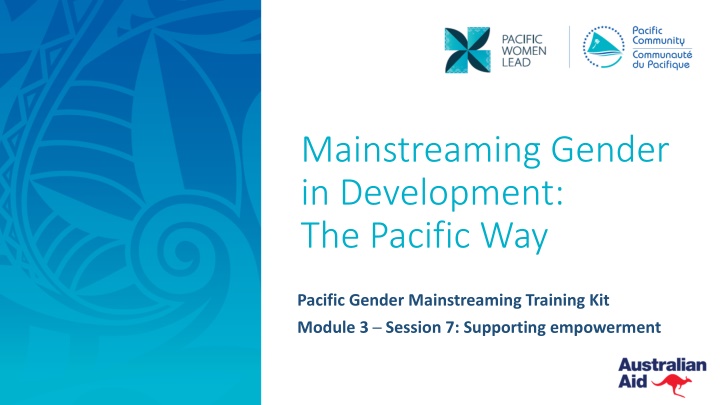
Supporting Women's Empowerment: Strategies and Needs
Explore the concept of women's empowerment and how mainstreaming gender can enhance development objectives. Learn about the characteristics of an empowered individual and practical ways to support empowerment by addressing strategic needs. Discover the importance of empowering women, empowering individuals, and contributing to gender equality in a holistic approach.
Uploaded on | 0 Views
Download Presentation

Please find below an Image/Link to download the presentation.
The content on the website is provided AS IS for your information and personal use only. It may not be sold, licensed, or shared on other websites without obtaining consent from the author. If you encounter any issues during the download, it is possible that the publisher has removed the file from their server.
You are allowed to download the files provided on this website for personal or commercial use, subject to the condition that they are used lawfully. All files are the property of their respective owners.
The content on the website is provided AS IS for your information and personal use only. It may not be sold, licensed, or shared on other websites without obtaining consent from the author.
E N D
Presentation Transcript
Mainstreaming Gender in Development: The Pacific Way Pacific Gender Mainstreaming Training Kit Module 3 Session 7: Supporting empowerment
Learning outcomes Learning outcomes At the end of this session you will understand: how mainstreaming gender can contribute to broader development objectives different measures that support women s empowerment.
What is an empowered person? What is an empowered person? Women s empowerment is a major strategy for progressing gender equality. An empowered person is someone who: is confident and in control of their life; has knowledge, skills, contacts; and can make decisions, be resourceful, understand people s rights, communicate well and influence decisions. Empowerment is a process of developing capacities and defined outcomes with the aim of being strong, intentional, and capable.
How can we support empowerment? How can we support empowerment? 1. Identify what people should know and do in relation to their sector. This could include questions like what is required to be a successful farmer, or to be healthy, or resilient to disasters. 2. Identify where the gaps are and whether women and men have all the resources they need. 3. Identify why the identified gaps exist, and whether the constraints regarding knowledge and skills and accessing resources are the same for women and men. In addition, we can ask what are the constraints women may face that men do not?
Practical and strategic needs Practical and strategic needs Practical needs Strategic needs Look at what resources women need such as training, financial services or access to a market. Look at why women do not have the same opportunities as men to access resources.
Empowerment is a strategic need Empowerment is a strategic need When women are empowered: they have more capacity they know their rights they are more resourceful they depend less on other people they have more opportunities to contribute their experience and skills in response to challenges.
The what and the how The what and the how Empowerment is not always about what to do but how to do it, including how a programme is being implemented and how services are being delivered. For instance, a project on developing aquaculture can empower women by: recognising women s role in the aquaculture system and valuing their contribution ensuring women involved in aquaculture have equal opportunity to be trained and receive information working with men and women to reinvest their incomes in something that will benefit the family and ensuring that women benefit equally from their hard work.
Evaluation questions Evaluation questions 1. Explain why women are less empowered than men. 2. Give two examples of measures that can support women s empowerment.
Evaluation questions Evaluation questions 1. Women are generally less empowered than men because: a)They are weaker. b)They don t have enough experience to make decisions. c) Women s access to opportunities, information, rights, and decisions is limited. d)It is normal.
Evaluation questions Evaluation questions 2. What difference does it make when women are empowered? a)They share their experiences, express their views and influence decisions. b)They have more capacity to access opportunities. c) They are more resilient. d)They boss men around.
